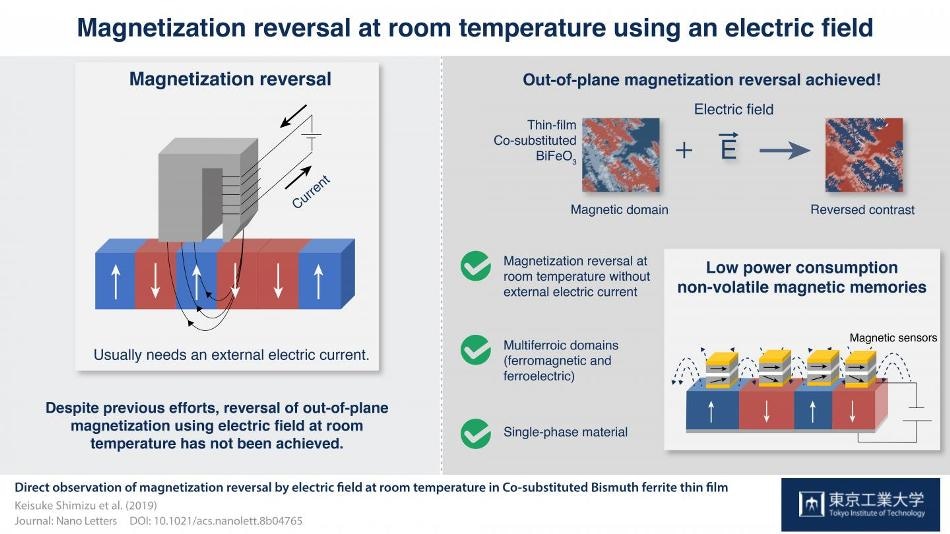Feb 25 2019
Researchers at Tokyo Institute of Technology accomplished magnetization reversal in cobalt-substituted bismuth ferrite by applying merely an electric field. Such an effect had been searched for more than a decade so as to design new types of low-power-consumption magnetic memory devices.
 Magnetization reversal at room temperature using an electric field. (Image credit: Keisuke Shimizu, Masaki Azuma, Tokyo Institute of Technology)
Magnetization reversal at room temperature using an electric field. (Image credit: Keisuke Shimizu, Masaki Azuma, Tokyo Institute of Technology)
In the age of information technology revolution, electronics demand fast evolution aided by greater efforts from materials scientists to ease the way for more improvements and innovative devices. Particularly, a better insight into the electromagnetic properties of different types of materials and new methods to harness them would enable the fabrication of devices based on similar principles.
Two years ago, a study team from the Laboratory for Materials and Structures at Tokyo Institute of Technology (Tokyo Tech), headed by Prof. Masaki Azuma, showed very promising properties of cobalt-substituted bismuth ferrite (BFCO). This strange material displays both ferroelectric and ferromagnetic properties at ambient temperature; these two are joined in a way that, the team concluded, could be manipulated to display reversal of the magnetization of the material by application of just an electric field at ambient temperature without the requirement of electric current.
In a more recent research, the team demonstrated confirmation of this hypothesized magnetization reversal in thin films of BFCO at room temperature. While earlier scientists witnessed some success in attaining magnetization reversal, their outcomes were for in-plane magnetization on a multi-layer material, which has certain disadvantages.
Direct observation of magnetization reversal on a single-phase material with ferroelectric and ferromagnetic orderings is crucial to the study of the intrinsic coupling between them. Moreover, out-of-plane magnetization reversal is desirable from the viewpoint of integration.
Masaki Azuma, Professor, Laboratory for Materials and Structures, Tokyo Institute of Technology.
Therefore, the researchers created thin BFCO films that displayed spontaneous magnetization. Since BFCO is highly sensitive to lattice strain, these thin films were grown on orthorhombic GdScO3, whose lattice structure corresponds to that of BFCO maximally and boost the growth of very crystalline films with marginal lattice strain. After confirming the existence of the sought-after out-of-plane magnetization, the team pursued investigating the correlation between the ferromagnetic and ferroelectric domains to examine if magnetization reversal was achievable by swapping electric polarization.
In the subsequent piezoelectric force microscopy and magnetic force microscopy images, the scientists learned that their trials were fruitful and that it was actually possible to attain out-of-plane magnetization reversal by applying an electric field at ambient temperature. This signifies the first time that such a feat was performed, and could, in the future, become the working principle of a new type of memory device, as elucidates Azuma: “The current demonstration of magnetic reversal using an electric field paves the way to low power consumption, non-volatile magnetic memories, such as magnetoresistive random-access memories.”
These results also offer hope to all scientists in this specific field who, although had collectively been investigating magnetization reversal for 15 years, had not yet stated such favorable results.